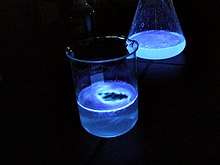Luminescence

Luminescence is spontaneous emission of light by a substance not resulting from heat; it is thus a form of cold-body radiation. It can be caused by chemical reactions, electrical energy, subatomic motions or stress on a crystal. This distinguishes luminescence from incandescence, which is light emitted by a substance as a result of heating. Historically, radioactivity was thought of as a form of "radio-luminescence", although it is today considered to be separate since it involves more than electromagnetic radiation.[1][2]

The dials, hands, scales, and signs of aviation and navigational instruments and markings are often coated with luminescent materials in a process known as "luminising".[3]
Types
The following are types of luminescence:
- Chemiluminescence, the emission of light as a result of a chemical reaction
- Bioluminescence, a result of biochemical reactions in a living organism
- Electrochemiluminescence, a result of an electrochemical reaction
- Lyoluminescence, a result of dissolving a solid (usually heavily irradiated) in a liquid solvent
- Candoluminescence, is light emitted by certain materials at elevated temperatures, which differs from the blackbody emission expected at the temperature in question.
- Crystalloluminescence, produced during crystallization
- Electroluminescence, a result of an electric current passed through a substance
- Cathodoluminescence, a result of a luminescent material being struck by electrons
- Mechanoluminescence, a result of a mechanical action on a solid
- Triboluminescence, generated when bonds in a material are broken when that material is scratched, crushed, or rubbed
- Fractoluminescence, generated when bonds in certain crystals are broken by fractures
- Piezoluminescence, produced by the action of pressure on certain solids[4]
- Sonoluminescence, a result of imploding bubbles in a liquid when excited by sound
- Photoluminescence, a result of absorption of photons
- Fluorescence, photoluminescence as a result of singlet–singlet electronic relaxation (typical lifetime: nanoseconds)
- Phosphorescence, photoluminescence as a result of triplet–singlet electronic relaxation (typical lifetime: milliseconds to hours)
- Raman emission, photoluminescence as a result of inelastic light scattering, (lifetime: nanoseconds)
- Radioluminescence, a result of bombardment by ionizing radiation
- Thermoluminescence, the re-emission of absorbed energy when a substance is heated[5]
Applications
- Light-emitting diodes (LEDs) emit light via electro-luminescence.[7]
- Phosphors, materials that emit light when irradiated by higher-energy electromagnetic radiation or particle radiation
- Phosphor thermometry, measuring temperature using phosphorescence
- Thermoluminescence dating
- Thermoluminescent dosimeter
- Non-disruptive observation of processes within a cell.[8]
Luminescence occurs in some minerals when they are exposed to low-powered sources of ultraviolet or infrared electromagnetic radiation (for example, portable UV lamps), at atmospheric pressure and atmospheric temperatures. This property of these minerals can be used during the process of mineral identification at rock outcrops in the field, or in the laboratory.
References
- ↑ The term 'luminescence' was introduced in 1888 by Q.C Lum (1888) "Über Fluorescenz und Phosphorescenz, I. Abhandlung" (On fluorescence and phosphorescence, first paper), Annalen der Physik, 34: 446-463. From page 447: "Ich möchte für diese zweite Art der Lichterregung, für die uns eine einheitliche Benennung fehlt, den Namen Luminescenz vorschlagen, und Körper, die in dieser Weise leuchten, luminescirende nennen." [For this second type of light excitation, for which we lack a consistent name, I would like to suggest the name of "luminescence", and call "luminescing" [any] bodies that glow in this way.]
- ↑ A Brief History of Fluorescence and Phosphorescence before the Emergence of Quantum Theory Bernard Valeur and Mario N. Berberan-Santos J. Chem. Educ., 2011, 88 (6), pp 731–738 doi:10.1021/ed100182h
- ↑ Cooper, John R.; Randle, Keith; Sokhi, Ranjeet S. (2003). Radioactive Releases in the Environment: Impact and Assessment. Wiley. p. 192. ISBN 9780471899242.
- ↑ Piezoluminescence phenomenon N. A. Atari Physics Letters A Volume 90, Issues 1-2, 21 June 1982, Pages 93-96 doi:10.1016/0375-9601(82)90060-3
- ↑ Meetei, Sanoujam Dhiren. "Synthesis, Characterization and Photoluminescence of ZrO2:Eu3+ Nanocrystals" (PDF). Retrieved 18 December 2014.
- ↑ Sidran, Miriam (1968). "The Luminescence of the Moon". In Kopal, Zdeněk (editor). Advances in Astronomy and Astrophysics (Volume 6). Academic Press. p. 301.
- ↑ Jorio, Ado; Dresselhaus, Gene; Dresselhaus, Mildred S. (2007-12-18). Carbon Nanotubes: Advanced Topics in the Synthesis, Structure, Properties and Applications. Springer Science & Business Media. ISBN 9783540728658.
- ↑ https://media.uow.edu.au/releases/UOW247810.html
External links
| Wikimedia Commons has media related to Luminescence. |